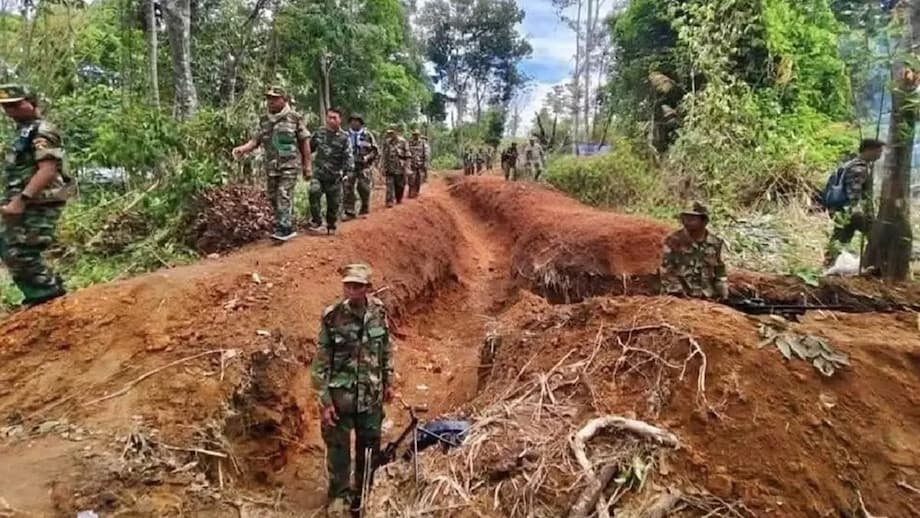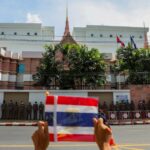A race to reopen classrooms along the frontier
Cambodia’s Ministry of Education, Youth and Sport has launched a plan to repair, rebuild, and safely reopen hundreds of schools along the Thai border after the worst fighting in more than a decade. Recent clashes forced the closure of 605 schools, disrupting learning for about 150,000 students and more than 6,000 teachers. Education minister Hang Chuon Naron has directed teams to move quickly on inspections, temporary classrooms, and coordination with mine clearance units so that campuses are safe before construction begins.
- A race to reopen classrooms along the frontier
- What the ministry plans to do now
- Why mine clearance comes first
- How the fighting shut classrooms on both sides
- Ceasefire and the push for stability
- What this means for border communities
- Timelines, costs, and who pays
- Risks that could slow work
- How parents and teachers can prepare
- What to Know
The border crisis escalated in late July after months of tension over undemarcated stretches of frontier near historic temples such as Preah Vihear. Heavy weapons were used and civilians were caught in the cross fire. A ceasefire took effect on 28 July following talks hosted in Malaysia, yet sporadic incidents and shelling reports kept communities wary. The disruption has affected public services on both sides of the border, closed dozens of health facilities, and triggered mass evacuations.
At a planning meeting chaired by Deputy Prime Minister and education minister Hang Chuon Naron, the ministry assigned technical teams to inspect damage at specific sites in Oddar Meanchey and Preah Vihear. The work includes drafting standard blueprints for classrooms and libraries, preparing project budgets for policy approval, and planning construction schedules geared to the 2025 to 2026 academic year. Temporary learning spaces will be set up so that teaching can continue while buildings are repaired or replaced. If security conditions block construction, the ministry will open the new school year in safe alternative locations away from the border.
What the ministry plans to do now
The education ministry’s plan focuses on field verification of damage, safe site preparation, and fast construction using standard school designs. The goal is to limit the time students spend in temporary settings while raising the quality and durability of permanent facilities.
Inspections and standardized designs
Officials will carry out on site inspections at damaged schools to determine whether structures can be repaired or require full replacement. The ministry has tasked engineers to finalize standard designs for classrooms and libraries that meet national safety and accessibility rules. Budgets are being prepared in parallel so that procurement can begin as soon as the sites are cleared of hazards. Provincial education departments will feed local needs into these designs so that rebuilt schools reflect class sizes, water and sanitation needs, and space for libraries and science rooms.
Temporary learning spaces
While construction unfolds, students will study in temporary classrooms and other learning spaces close to their communities. Education teams are working with local authorities to identify safe plots for these facilities, to bring in furniture and teaching materials, and to set up reliable schedules that match the regular timetable as closely as possible. The ministry’s instructions emphasize continuity of teaching and learning so that students do not lose a term while waiting for permanent buildings.
Alternative school sites and safe access
In areas where instability continues, classes will be shifted to safer towns or districts. Transport options, safe routes, and communication with parents form part of the logistics planning. Officials say priority will be given to final year students facing exams, children with disabilities who need accessible facilities, and younger grades that require shorter travel times. School administrators are being asked to keep tight records of enrollment so that every displaced learner is assigned a classroom in the temporary or alternate system.
Why mine clearance comes first
Before any brick is laid, teams must make sure school grounds and approaches are free of explosive hazards. The Cambodian Mine Action and Victim Assistance Authority has urged a coordinated push to clear unexploded ordnance and landmines at schools, health centers, pagodas, homes, and farm fields along the border. This work is essential for the safe return of families and the safety of construction crews. Clearance teams survey suspected areas, mark hazards, and then deploy trained deminers to remove or destroy items such as artillery shells, rockets, and anti personnel mines. Even small fragments can threaten children who walk to school or play in fields.
Mine action authorities have also highlighted concerns raised by border communities about explosive remnants from recent fighting. Rights monitors condemned the use of cluster munitions in populated areas. Cambodian officials have accused Thai forces of using banned weapons, claims that Thai officials reject. Thai authorities, for their part, accused Cambodia of newly planted landmines inside Thai territory. Independent verification is limited near active conflict zones, which is why thorough survey and clearance is central to reopening schools safely.
Practical challenges add to the urgency. A comprehensive border survey launched in late 2024, initially due by mid 2025, has been delayed by the fighting. Mine action leaders have asked development partners such as the United Nations Development Programme to expand support for impact assessments, clearance work, and victim assistance. The education ministry will line up construction schedules with clearance timetables so that no repair crew moves onto a site until mine action teams give clear approval.
How the fighting shut classrooms on both sides
Education has been disrupted across the frontier. In Thailand, authorities temporarily closed 751 schools across several eastern and northeastern provinces close to the border, including Ubon Ratchathani, Sisaket, Buri Ram, Surin, Sa Kaeo, and Chanthaburi. Thailand’s Public Works Department has inspected damaged buildings in seven provinces and set up damage assessment centers, reporting hundreds of houses hit and multiple government facilities affected, including schools and hospitals. These actions mirror the scale of disruption reported inside Cambodia, where 605 schools were shuttered in border provinces.
The U.S. Embassy in Thailand issued a broad travel warning during the escalation and described the scope of security measures. In a public advisory, embassy officials cautioned travelers to stay well away from the frontier and outlined emergency steps taken by Thai authorities.
The U.S. citizens are advised to avoid all travel to the area within 50 kilometers of the Thailand Cambodia border due to ongoing military conflict in the region.
Inside Cambodia, local education offices in Oddar Meanchey and Preah Vihear have worked with the ministry to track damaged classrooms, arrange temporary sites, and plan repairs. Reports detail the condition of buildings, availability of safe land for temporary structures, and the supplies needed to run classes until reconstruction finishes.
Ceasefire and the push for stability
Regional diplomacy helped reduce the immediate danger to schools and communities. Cambodia and Thailand agreed to halt fighting after a meeting in Malaysia on 28 July. The pause followed weeks of clashes that, according to international and local reports, killed civilians and soldiers and sent more than one hundred thousand people from their homes. Border villages emptied out as families moved to shelters in schools, pagodas, and open fields. Heavy weaponry, including air power and rocket artillery, was used near contested temple zones. Cultural sites sustained damage, and both sides traded accusations over who started the fighting.
U.S. pressure helped push the talks forward. U.S. President Donald Trump described his outreach to both leaders and cast the goal in direct terms. In a public social media post, he wrote:
Both Parties are looking for an immediate Ceasefire and Peace
ASEAN mediation, led by Malaysia, remains central to next steps. Health and humanitarian agencies describe a fragile environment. World Health Organization partners reported that by mid August the number of internally displaced people in Cambodia had fallen from peaks as families began returning, yet many stayed in crowded shelters with limited water, sanitation, and access to health services. Cambodian authorities also reported that a number of soldiers captured during the fighting remained in custody across the border, a point of tension that could affect conditions near schools if talks stall. The ceasefire created space for education planners to move, but the safety picture can shift quickly in border districts that have seen periodic flare ups for years.
What this means for border communities
Families want predictable school schedules, safe routes, and the return of daily routines. After weeks of displacement, many children are living in temporary sites with little privacy, irregular access to clean water, and few places to study. Teachers are coping with their own losses while checking on students spread across evacuation centers, host communities, and newly reopened villages. These strains often lead to absenteeism, anxiety, and learning loss. The ministry’s plan acknowledges that school reopening is not only about bricks and mortar. It also depends on transport, health services, and social support around each campus.
Temporary classrooms will need reliable water and sanitation, shaded areas to manage heat, and safe storage for learning materials. Repaired schools must include accessible toilets, basic handwashing points, and fencing to keep children away from any nearby clearance zones. Education officers are coordinating with local health departments to monitor student welfare and to support teachers who are running combined classes or split shifts while permanent buildings are completed.
Timelines, costs, and who pays
Officials are drafting budgets that match site conditions, standard designs, and the scale of repairs. Funding will likely come from a mix of government resources and development partners, with mine action financed through ongoing clearance programs and new appeals. The Cambodian Mine Action and Victim Assistance Authority has asked for expanded international support to complete impact assessments and deploy clearance teams more widely along the border. Education planners are moving in step with that request so that construction can start as soon as mine action confirms that a campus is safe.
The aim is to be ready for the 2025 to 2026 academic year, which begins in early November. That timeline depends on calm along the frontier, access to sites for inspection and clearance, and the availability of materials and contractors. In districts where fieldwork cannot begin in time, the ministry will run the first term from safe locations away from the border. The approach is designed to give every learner a seat in class, even if their home school is still under repair.
Risks that could slow work
Planners and communities are watching several risks that could complicate the push to reopen schools at the border.
- Unexploded ordnance can delay crews and restrict access to school grounds until teams complete survey and clearance.
- A fragile ceasefire could limit movement or force fresh evacuations if incidents flare near towns and villages.
- Seasonal rains and poor road conditions can slow deliveries of cement, roofing, and classroom furniture.
- Damage to power and water networks may add temporary costs to run generators or bring water by truck.
- Teacher shortages may arise if staff are displaced or assigned to split shifts across temporary sites.
- Remote communities can face longer travel times to alternate schools, which affects attendance and safety.
Officials say the plan to use temporary classrooms and alternative sites is meant to reduce these risks by keeping students learning while engineering and clearance teams finish their work.
How parents and teachers can prepare
Local coordination will help the plan succeed. Families and school staff can take small steps that make reopening smoother and safer.
- Check announcements from provincial education departments for the location of temporary classrooms or alternate schools.
- Confirm enrollment lists so that every student is registered at a temporary or alternate site.
- Map safe routes and avoid any marked or suspected hazardous areas around former fighting zones.
- Work with school committees to organize shared transport or walking groups for younger children.
- Encourage regular attendance and keep basic study routines at home while schedules stabilize.
- Watch for signs of stress among students and teachers, and ask local health workers about available support.
What to Know
- Education officials will inspect more than 600 damaged schools and launch repairs with standard designs for classrooms and libraries.
- Temporary learning spaces will operate while permanent buildings are rebuilt, with alternate school sites ready if border areas remain unsafe.
- Mine clearance is a prerequisite for any construction, and clearance teams will work with the education ministry to certify sites as safe.
- Recent clashes closed 605 schools in Cambodia and 751 schools in nearby Thai provinces, reflecting a border wide disruption.
- A ceasefire took effect on 28 July after talks in Malaysia, creating space for reconstruction but not removing all security risks.
- Humanitarian reports cite high displacement, crowded shelters, and pressure on health services, which affect how quickly schools can reopen.
- Budgets and policy approvals are being prepared now so that projects can start in time for the 2025 to 2026 school year in early November.
- Parents and teachers are encouraged to follow official notices, confirm enrollment, and prioritize safe routes to temporary or alternate school sites.




